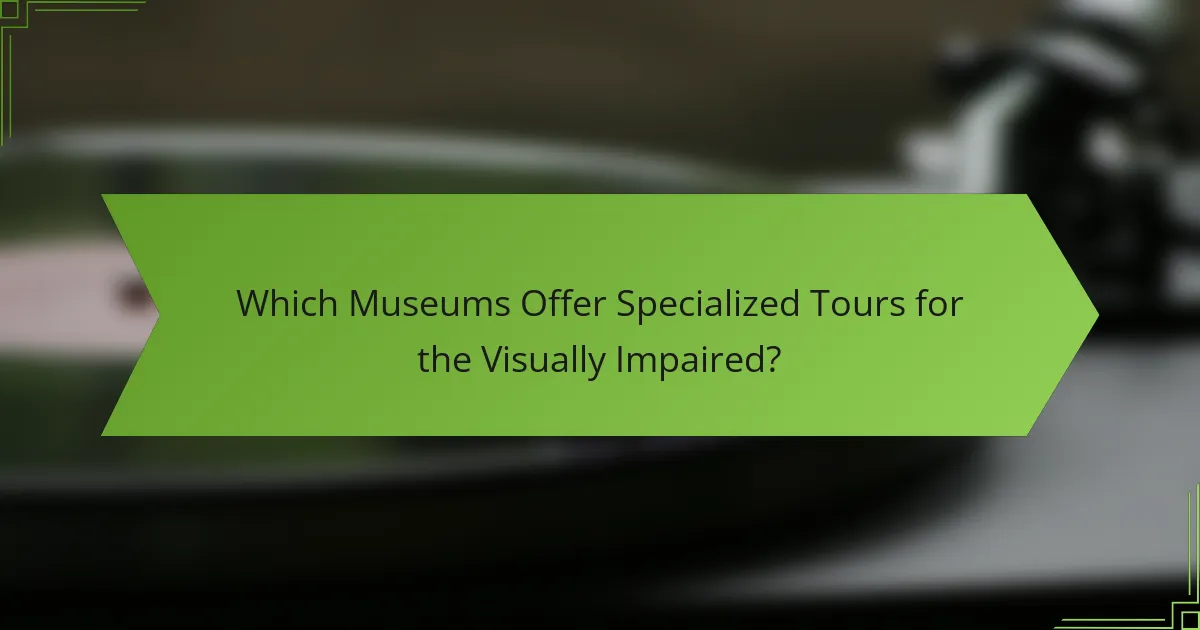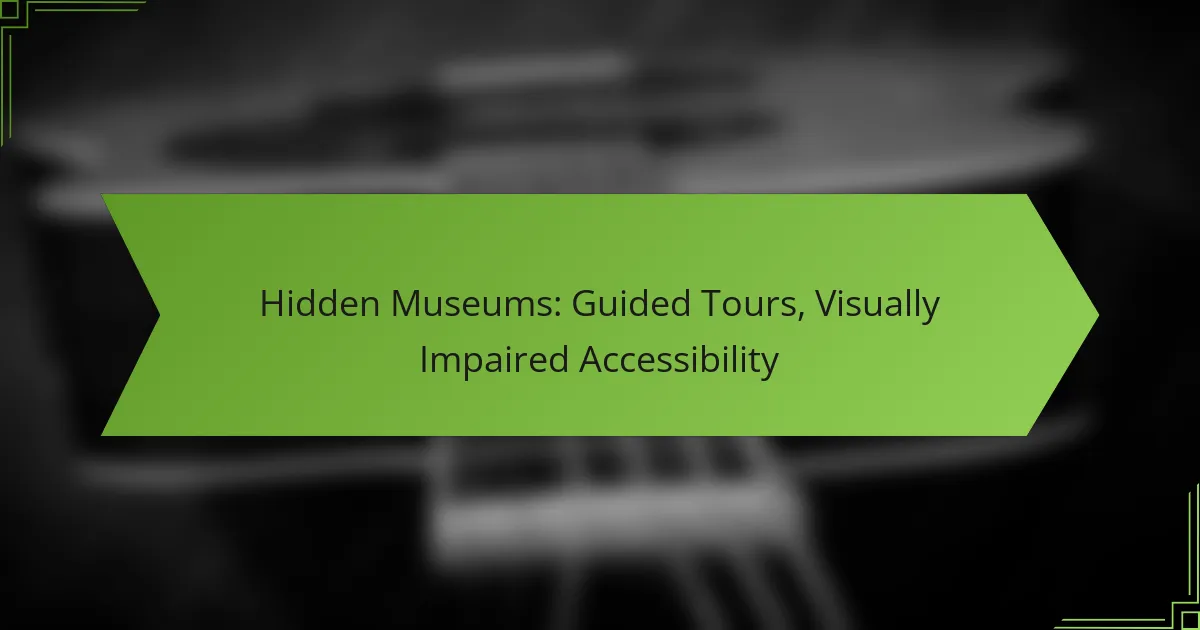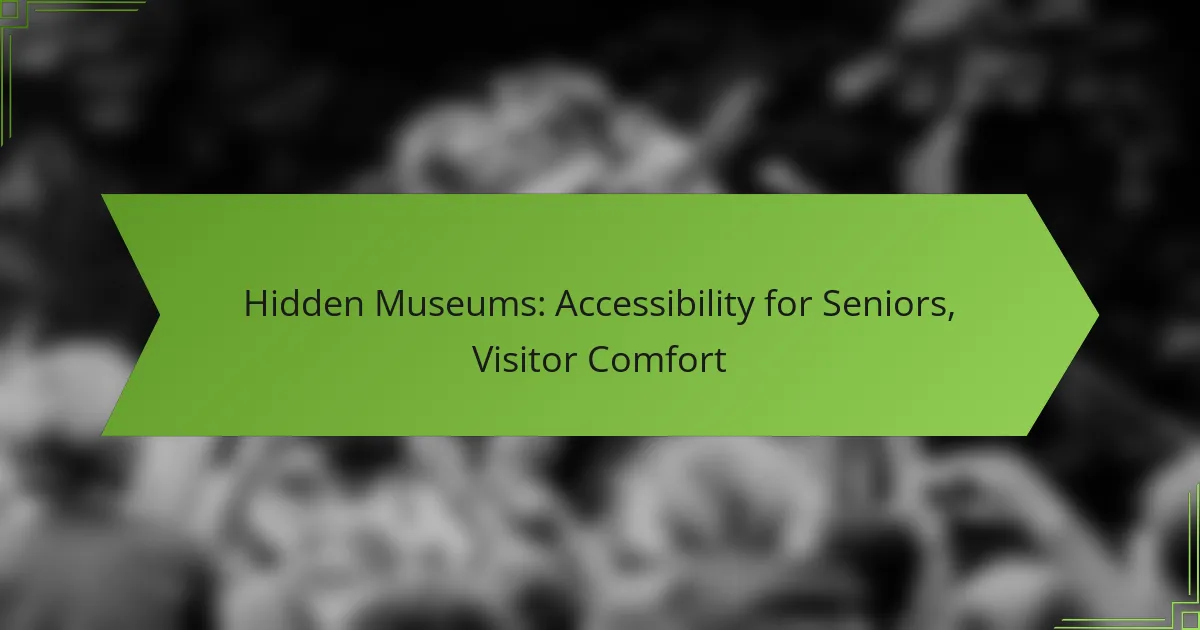Hidden museums often feature guided tours that explore unique and niche topics, providing visitors with engaging insights and expert knowledge. These tours not only enhance the overall experience but also make art and history more accessible. Additionally, many of these museums prioritize inclusivity by offering tailored services for visually impaired visitors, such as audio descriptions and touch tours, ensuring that everyone can enjoy the rich offerings of these lesser-known cultural gems.

What Are the Best Hidden Museums for Guided Tours?
Some of the best hidden museums for guided tours offer unique experiences that delve into niche topics, often overlooked by mainstream attractions. These museums provide engaging insights through knowledgeable guides, making them ideal for those seeking something different.
The Museum of Jurassic Technology
The Museum of Jurassic Technology in Los Angeles combines art and science in a quirky, thought-provoking way. Visitors can explore exhibits that blur the lines between fact and fiction, featuring everything from miniature dioramas to obscure scientific curiosities.
Guided tours enhance the experience by providing context and stories behind the exhibits, making it a must-visit for those interested in the unusual. Reservations are recommended, especially on weekends, to ensure a spot on a guided tour.
The Spy Museum
Located in Washington, D.C., The Spy Museum offers an interactive look into the world of espionage. With a vast collection of spy gadgets, artifacts, and stories from real-life spies, the museum provides a captivating experience for visitors of all ages.
Guided tours are available and often include special insights into the history of spying and its impact on global events. Be sure to check the schedule for themed tours that may focus on specific aspects of espionage.
The Tenement Museum
The Tenement Museum in New York City tells the stories of immigrants who lived in a historic tenement building on the Lower East Side. Guided tours take visitors through restored apartments, showcasing the lives of families from various backgrounds.
These tours are immersive, often featuring actors who portray historical figures, making the experience both educational and engaging. Booking in advance is advisable, as tours can fill up quickly, especially during peak tourist seasons.
The Museum of the American Gangster
Located in New York City, The Museum of the American Gangster focuses on the history of organized crime in America. The museum features exhibits on notorious figures and events, providing a unique perspective on this often glamorized aspect of American history.
Guided tours offer deeper insights into the stories behind the exhibits, making it an intriguing visit for those interested in crime history. Check for special events or lectures that may coincide with your visit for an enhanced experience.
The International Cryptozoology Museum
The International Cryptozoology Museum in Portland, Maine, is dedicated to the study of hidden or unknown animals. It features exhibits on legendary creatures like Bigfoot and the Loch Ness Monster, appealing to those fascinated by the unexplained.
Guided tours provide an opportunity to learn about the science and folklore behind cryptozoology, making it a fun and educational experience. Consider visiting during special events or lectures for a more in-depth exploration of the subject matter.

How Do Guided Tours Enhance the Experience?
Guided tours significantly enhance the museum experience by providing expert knowledge and context that enriches understanding. They offer visitors a structured way to engage with exhibits, making art and history more accessible and meaningful.
Expert Insights
Guided tours are led by knowledgeable guides who share valuable insights about the exhibits. These experts often have backgrounds in art history, archaeology, or cultural studies, allowing them to provide deeper context and answer questions that arise during the visit.
For instance, a guide might explain the historical significance of a particular painting or the techniques used by the artist, which can transform a simple viewing into a profound learning experience. This personalized interaction can help visitors connect emotionally with the artwork.
Curated Narratives
Guided tours often present curated narratives that weave together various pieces of art or artifacts into a cohesive story. This storytelling approach helps visitors understand the connections between different works and the broader cultural or historical themes they represent.
For example, a tour might focus on the evolution of a specific art movement, showcasing key pieces while explaining their relevance in the context of societal changes. This narrative structure makes the experience more engaging and memorable.
Interactive Elements
Many guided tours incorporate interactive elements to enhance visitor engagement. This can include hands-on activities, discussions, or even technology like augmented reality to provide a multi-sensory experience.
For instance, some museums offer tactile experiences for visually impaired visitors, allowing them to touch replicas of sculptures or use audio guides that describe the exhibits in detail. These interactive components not only make the tour more enjoyable but also cater to diverse learning styles and accessibility needs.

What Accessibility Options Are Available for the Visually Impaired?
Many museums offer various accessibility options for visually impaired visitors, enhancing their experience through tailored services. Key options include audio descriptions, touch tours, and Braille signage, each designed to provide a more inclusive environment.
Audio Descriptions
Audio descriptions provide a narrated account of visual elements in exhibits, allowing visually impaired visitors to understand the context and details of artworks or artifacts. These descriptions are typically available through handheld devices or mobile apps, making them easily accessible during tours.
When planning a visit, check if the museum offers audio guides specifically designed for the visually impaired. Some institutions may provide these services for free, while others might charge a nominal fee.
Touch Tours
Touch tours allow visitors to physically interact with select objects or replicas, enhancing their understanding through tactile experiences. These tours are often guided by trained staff who explain the significance of each item while ensuring a safe and informative experience.
It’s advisable to book touch tours in advance, as they may have limited availability. Museums often schedule these tours at specific times, so checking the museum’s website or contacting them directly can help secure a spot.
Braille Signage
Braille signage is crucial for navigating museum spaces, providing essential information about exhibits and facilities. This type of signage is typically placed at key locations, such as entrances, restrooms, and exhibit descriptions, ensuring that visually impaired visitors can move independently.
When visiting, look for museums that prominently feature Braille signage throughout their facilities. This can significantly enhance the overall experience by promoting autonomy and ease of navigation.

Which Museums Offer Specialized Tours for the Visually Impaired?
Several museums provide specialized tours designed for the visually impaired, enhancing accessibility and engagement through tactile experiences and audio descriptions. These tours often include trained guides who facilitate a deeper understanding of the exhibits.
The Metropolitan Museum of Art
The Metropolitan Museum of Art in New York City offers a variety of programs tailored for visually impaired visitors. These include guided tours that focus on tactile exploration of select artworks, allowing participants to touch replicas and engage with the art in a meaningful way.
Additionally, the museum provides audio descriptions of exhibits, which help convey the visual elements of the artworks. Reservations are recommended, and tours can often be customized to fit the needs of the group.
The British Museum
The British Museum in London features specialized tours for visually impaired guests that emphasize sensory engagement. These tours often include the use of tactile materials and detailed verbal descriptions, enhancing the visitor’s experience of the museum’s vast collection.
Participants can expect to explore key artifacts through touch and sound, with trained guides facilitating discussions about the historical context and significance of each piece. Booking in advance is advisable to ensure availability.
The Getty Center
The Getty Center in Los Angeles offers programs specifically designed for visitors with visual impairments, including guided tours that highlight the museum’s art and architecture. These tours incorporate tactile opportunities and descriptive audio to create an inclusive experience.
Visitors can engage with select artworks through touch and receive detailed descriptions that bring the pieces to life. It is recommended to check the Getty’s website for specific tour schedules and to reserve spots ahead of time, as spaces may be limited.

What Are the Benefits of Accessible Guided Tours?
Accessible guided tours provide significant advantages by ensuring that individuals with visual impairments can fully engage with museum exhibits. These tours enhance the overall experience, making cultural education inclusive and enriching for all participants.
Inclusivity
Inclusivity in accessible guided tours means creating an environment where everyone, regardless of their abilities, can participate in cultural experiences. This approach not only welcomes visually impaired individuals but also fosters a sense of community among diverse groups.
To achieve inclusivity, museums can implement training programs for guides on how to communicate effectively with visually impaired visitors. Additionally, incorporating tactile exhibits and audio descriptions can significantly enhance the experience for all attendees.
Enhanced Engagement
Enhanced engagement occurs when guided tours are designed to actively involve participants through various sensory experiences. For visually impaired individuals, this might include touchable artifacts, descriptive audio, and interactive elements that encourage exploration.
Museums can improve engagement by offering specialized tours that focus on storytelling and personal connections to the exhibits. This not only captivates the audience but also deepens their understanding and appreciation of the art and history presented.



